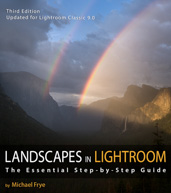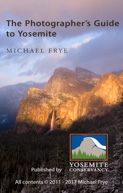Yosemite Photo Conditions
by Michael Frye | Apr 15, 2009 | Yosemite Photo Conditions

I’ve heard reports of the first buds appearing on the dogwoods in Yosemite Valley. This puts them on track for their typical blooming period, which usually begins near the end of April and continues through about mid-May. I prefer to photograph them when they first bloom, before the leaves get large enough to obscure the blossoms. You can’t photograph them from behind, as I did in the photograph above, after they’re leafed out. If you miss the show in Yosemite Valley, they bloom about two weeks later at higher elevations, like the Tuolumne Grove of giant sequoias.
Of course the main pursuit for Yosemite photographers in the spring is waterfalls. This is shaping up to be a typical spring, which means the peak flow should arrive around the end of May or beginning of June. Meanwhile the water flow will fluctuate with the weather—the warmer the temperature, the higher the runoff.
Yosemite Falls, the big spring attraction, gets basically terrible light this time of year. But the other big three—Vernal, Nevada, and Bridalveil—are all positioned to receive late-afternoon sunlight. You can find rainbows on all three between about 5 to 7 p.m. depending on your viewpoint. The Mist Trail opened recently, giving access to Vernal and Nevada Falls. The trail is usually crowded, but for good reason—in the spring it has to be one of the world’s most spectacular day hikes.
by Michael Frye | Apr 6, 2009 | Yosemite Photo Conditions

The poppies are mostly gone from the Merced River Canyon, but other flowers have replaced them—although in smaller quantities. Lupine, owl’s clover, and gilia have formed small carpets throughout the canyon, and the redbud are near their peak. I made this photograph of lupine, owl’s clover, and poppies near El Portal on Saturday.
In Yosemite Valley it’s still too early for dogwoods. They usually start blooming near the end of the month. Late April is also when the deciduous trees start leafing out. Cottonwoods, alders, and maples turn bright green, while black oak leaves often appear red or orange when they first appear.
The last few days have been warm, but rain is predicted for tomorrow, with snow possible down to 5000 feet on Wednesday. Another weather system is supposed to arrive Friday. This cooler, wetter weather will temporarily reduce the flow in the waterfalls, but help preserve the snowpack for May and June. It’s too early to tell how this weather might affect the timing of the dogwoods—for now I still expect them to arrive at their usual time in late April. Of course any rain or snow provides opportunities for clearing storm photographs.
by Michael Frye | Mar 27, 2009 | Yosemite Photo Conditions

Last weekend’s storm brought the precipitation total for the season in Yosemite Valley up to 31.35 inches. The average through the end of March is 30.5 inches, so we’re a little above that. It looks like it might be a “typical” spring in Yosemite Valley, which would mean that dogwoods would begin blooming around the end of April, the peak flow in the waterfalls would be around the end of May, and Tioga Pass would open just before Memorial Day. Of course the weather in April will have a big influence on all of that.
The poppies in the Merced River Canyon are finally starting to fade, although there will still be some nice patches around for awhile. Some new flowers are emerging, including lupine and dense groves of tri-colored gilia. The photograph above, including poppies and gilia, was made two days ago along the Hite’s Cove trail.
by Michael Frye | Mar 21, 2009 | Yosemite Photo Conditions

The
National Weather Service is predicting a cold, wintry storm to reach Yosemite tonight and tomorrow. The snow level will be high—7500 to 8000 feet—to start, but it’s expected to drop as low as 3000 feet on Sunday.
A storm like this always provides good photo opportunities, especially as it’s clearing (probably Sunday afternoon or Monday morning). But what will it do to the poppies in the Merced River Canyon?
Overall the poppies still look great. Some of the earliest-blooming spots in the burned area have started to fade, but have been replaced by others. More than replaced actually, as the overall acreage in bloom has expanded. Although the snow level with this storm is unlikely to drop low enough to snow on the flowers, it will still become cold and wet, which might cause some poppies to pack it in for the season. But I don’t expect them all to disappear overnight.
Redbud are also starting to bloom in the Merced River Canyon west of Yosemite. Only a few have reached their peak color, but many more should come out in the next week or so.
The photograph above, Redbud and Oaks, will be one of the raffle prizes at the
Sierra Foothill Conservancy‘s Spring Celebration tomorrow from 2:00 to 5:00 p.m. at Michael and Jeanne Adams’ house, 5054 Bullion Street, Mariposa. This should be a really fun event, and supports the great work that the Sierra Foothill Conservancy does, so I hope you can stop by if you’re in the area. For more information email Bridget Fithian: bridget.fithian@hotmail.com.
by Michael Frye | Mar 17, 2009 | Photography Tips, Yosemite Photo Conditions
 The spring equinox is only a few days away, and the light is changing rapidly in Yosemite Valley. In winter the rising and setting sun strikes formations on the north side of the valley like El Capitan, Three Brothers, and Yosemite Falls. In summer the best light shifts to the rocks and falls on the south side of the valley – Glacier Point, Sentinel Rock, Cathedral Rocks, and Bridalveil Fall.
The spring equinox is only a few days away, and the light is changing rapidly in Yosemite Valley. In winter the rising and setting sun strikes formations on the north side of the valley like El Capitan, Three Brothers, and Yosemite Falls. In summer the best light shifts to the rocks and falls on the south side of the valley – Glacier Point, Sentinel Rock, Cathedral Rocks, and Bridalveil Fall.
For Yosemite Falls, the best light doesn’t match up with the biggest flow. As the water volume grows in spring, the sun rises further and further north, and the light doesn’t reach the falls until 9:30 to 10:00 a.m. in April and May.
But Bridalveil Fall is better situated for spring light. From late March through about the end of April the sun sets through a gap to the west, and Bridalveil receives beautiful golden light just before sunset. The accompanying photo was made on March 27th, 2007 from Tunnel View. In May and June the light gets cut off earlier, but it’s still nice.
Bridalveil Fall can be photographed from across the river along Northside Drive (location 4 in my book, The Photographer’s Guide to Yosemite), Valley View (location 5), Tunnel View (location 8), or from the Bridalveil Fall parking lot and trail (location 7). You can see a rainbow right from the parking lot between about 5:00 – 6:00 p.m. throughout the spring. (Unfortunately the book is temporarily out of print; it should be available again sometime this spring.)
Poppies Update:
The poppies in the Merced River canyon are still going strong. While the earliest-blooming spots – mainly in the burned areas – may start to fade soon, other areas have just started flowering and should last a little longer.
by Michael Frye | Mar 9, 2009 | Yosemite Photo Conditions

Since my post from February 28th, a little over a week ago, there’s been a poppy explosion in the Merced River Canyon. The acreage in bloom has probably tripled. Most are still in the burned area across the river from Highway 140, two to three miles east of Briceburg, where the flowers now reach to the tops of the ridges, but “Grandy’s Hill,” a bit further east on the highway side of the river, is blazing.
The vantage points looking across the river from the Highway are actually quite good. It’s possible to hike east from Briceburg to be on the poppy side of the river, but you’d have to climb up very steep hillsides to be among the flowers and get a decent view. Grandy’s Hill and most of the other poppy spots also require steep climbs for a close-up view. While these hills aren’t so steep that you’ll die if you fall (at least not in most places), you could easily slip and break and ankle, so don’t attempt this if you’re not agile and sure-footed. The one place where you can reach poppies easily is the beginning of the Hite’s Cove trail.
I made the accompanying photo of poppies and popcorn flowers on one of those steep hillsides yesterday. I used a 200mm lens to compress the space and create a pattern out of the bands of color.














